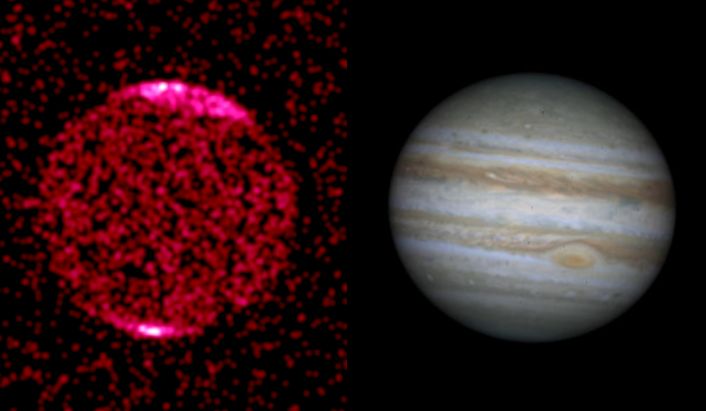Credit & Copyright: X-ray Image:
R.Gladstone
(SwRI), et al.,
Optical Image: Cassini
Imaging Team, NASA
Explanation:
The Solar System's largest planet,
gas
giant Jupiter, is famous
for its swirling
Great Red Spot.
In the right hand panel above, the familiar giant planet with
storm system and
cloud bands is shown in an
optical image from the passing
Cassini spacecraft.
In the left hand panel, a false-color image from the
orbiting
Chandra
Observatory presents a corresponding x-ray view of Jupiter.
The Chandra image
shows clearly, for the first time, x-ray spots and
auroral x-ray emission
from the poles.
The x-ray spot dominating the emission from Jupiter's
north pole (top)
is perhaps as surprising for astronomers today as the Great Red Spot
once
was.
Confounding previous theories,
the x-ray spot is too far north to be
associated with heavy electrically charged particles
from
the vicinity of volcanic moon Io.
Chandra data also show that the spot's
x-ray
emission mysteriously pulsates over a period of about 45 minutes.
1999 2000 2001 2002 2003 2004 2005 2006 2007 2008 2009 2010 2011 2012 2013 2014 2015 2016 2017 2018 2019 2020 2021 2022 2023 2024 2025 |
Yanvar' Fevral' Mart Aprel' Mai Iyun' Iyul' Avgust Sentyabr' Oktyabr' Noyabr' Dekabr' |
NASA Web Site Statements, Warnings, and Disclaimers
NASA Official: Jay Norris. Specific rights apply.
A service of: LHEA at NASA / GSFC
& Michigan Tech. U.
|
Publikacii s klyuchevymi slovami:
Jupiter - aurora - magnetic field - Yupiter - rentgenovskoe izluchenie - polyarnoe siyanie
Publikacii so slovami: Jupiter - aurora - magnetic field - Yupiter - rentgenovskoe izluchenie - polyarnoe siyanie | |
Sm. takzhe:
Vse publikacii na tu zhe temu >> | |
